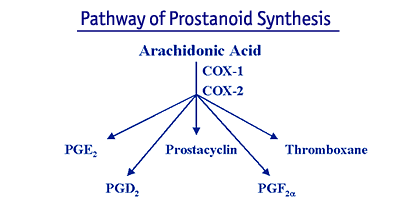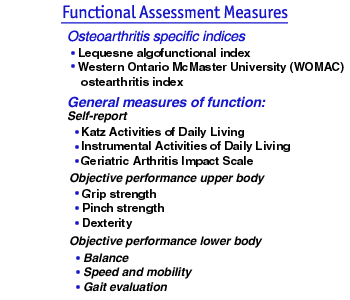By Joan M. Bathon, M.D. Updated December 2011 by Rebecca L. Manno, MD, MHS
- Pharmacological Therapies
- Intraarticular Therapies
- Non-pharmacological Management
- Surgical Management
- Functional Assessment
- Future Directions
- References
- Discussion of Specific COX-2 Inhibitors
Current treatment for OA is limited to control of symptoms. At this time, there are no pharmacological agents capable of retarding the progression of OA or preventing OA. This is a fundamental and important area of current research. In 2011, treatment is focused on relief of pain, maintenance of quality of life, and preservation of functional independence.
1) Acetaminophin: Several studies have shown acetaminophen to be superior to placebo and equivalent to nonsteroidal anti-inflammatory agents (NSAIDs) for the short-term management of OA pain. At present, acetaminophen (up to 4,000 mg/daily) is the recommended initial analgesic of choice for symptomatic OA. ( ACR Guidelines-Guidelines for Medical Management of OA of the knee) However, many patients eventually require NSAIDs or more potent analgesics to control pain.
2) Non-steroidal Anti-inflammatory Agents (NSAIDs): NSAIDs have been an important treatment for the symptoms of OA for a very long time. The mechanism by which NSAIDs exert their anti-inflammatory and analgesic effects is via inhibition of the prostaglandin-generating enzyme, cyclooxygenase (COX) . In addition to their inflammatory potential, prostaglandins also contribute to important homeostatic functions, such as maintenance of the gastric lining, renal blood flow, and platelet aggregation. Reduction of prostaglandin levels in these organs can result in the well-recognized side effects of traditional non-selective NSAIDs (ibuprofen, naprosyn, indomethacin) – that is, gastric ulceration, renal insufficiency, and prolonged bleeding time. The elderly are at higher risk for these side effects. Other risk factors for NSAID-induced GI bleed include prior peptic ulcer disease and concomitant steroid use. Potential renal toxicities of NSAIDs include azotemia, proteinura, and renal failure requiring hospitalization. Hematologic and cognitive abnormalities have also been reported with several NSAIDs. Therefore, in elderly patients, and those with a documented history of NSAID-induced ulcers, traditional non-selective NSAIDs should be used with caution, usually in lower dose and in conjunction with a proton pump inhibitor. Renal function should be monitored in the elderly. In addition, prophylactic treatment to reduce risk of gastrointestinal ulceration, perforation and bleeding is recommended in patients > 60 years of age with: prior history of peptic ulcer disease; anticipated duration of therapy of > 3 months; moderate to high dose of NSAIDs; and, concurrent corticosteroids. The development of selective cyclooxygenase-2 (COX-2) inhibitors offers a strategy for the management of pain and inflammation that is likely to be less toxic to the GI tract.
3) COX-2 Inhibitors: Cyclooxygenase-2 (COX-2) inhibitors are a class of NSAIDs) that recently received Food and Drug Administration (FDA) approval. These specific COX-2 inhibitors are effective for the pain and inflammation of OA. Their theoretical advantage, however, is that they will cause significantly less toxicity than conventional NSAIDs, particularly in the GI tract. NSAIDs exert their anti-inflammatory effect primarily by inhibiting an enzyme called cyclooxygenase (COX), also known as prostaglandin (PG) synthase. COX catalyzes the conversion of the substrate molecule, arachidonic acid, to prostanoids.

Prostanoids consist of prostaglandins E, D and F2a, prostacyclin and thromboxane. The major inflammatory vasoactive prostanoids are PGE2 and prostacyclin. Thromboxane is critical for platelet clotting, while PGD2 is involved in allergic reactions and PGF2a in uterine contraction.
4) Other Oral Analgesic Agents: For patients who cannot tolerate NSAIDs or COX-2 inhibitors other analgesics alone or in combination may be apporrpriate. Tramadol, a non-NSAID/COX2 non-opioid pain medication, can be effective to manage pain symptoms alone or in combination with acetaminophen. Opioids should be a last resort for pain management, often in late-stage disease, given their many side effects including constipation, somnolence, and potential for abuse.
5) Topical Agents: Topical analgesic therapies include topical capsaicin and methyl salicylate creams. There is an FDA approved topical NSAID for the treatment of OA, diclofenac gel, which can be particularly useful for patients who are intolerant to the gastrointestinal side effects of NSAIDs.
6) Intraarticular Therapies: The judicious use of intra-articular glucocorticoid injections is appropriate for OA patients who cannot tolerate, or whose pain is not well controlled by, oral analgesic and anti-inflammatory agents. Periarticular injections may effectively treat bursitis or tendonitis that can accompany OA. The need for four or more intra-articular injections suggests the need for orthopedic intervention. Intraarticular injection of hyaluronate preparations has been demonstrated in several small clinical trials to reduce pain in OA of the knee. These injections are given in a series of 3 or 5 weekly injections (depending on the specific preparation) and may reduce pain for up to 6 months in some patients.
Non-pharmacological Management
Weight reduction in obese patients has been shown to significantly relieve pain, presumably by reducing biomechanical stress on weight bearing joints. Exercise has also been shown to be safe and beneficial in the management of OA. It has been suggested that joint loading and mobilization are essential for articular integrity. In addition, quadricep weakness, which develops early in OA, may contribute independently to progressive articular damage. Several studies in older adults with symptomatic knee OA have shown consistent improvements in physical performance, pain and self-reported disability after 3 months of aerobic or resistance exercise. Other studies have shown that resistive strengthening improves gait, strength and overall function. Low-impact activities, including water-resistive exercises or bicycle training, may enhance peripheral muscle tone and strength and cardiovascular endurance, without causing excessive force across, or injury, to joints. Studies of nursing home and community-dwelling elderly clearly demonstrate that one additional important benefit of exercise is a reduction in the number of falls.
Patients in whom function and mobility remain compromised despite maximal medical therapy, and those in whom the joint is structurally unstable, should be considered for surgical intervention. Patients in whom pain has progressed to unacceptable levels-that is, pain at rest and/or nighttime pain-should also be considered as surgical candidates. Surgical options include arthroscopy, osteotomy and arthroplasty. Arthroscopic removal of intra-articular loose bodies and repair of degenerative menisci may be indicated in some patients with knee OA. Tibial osteotomy is an option for some patients who have a relatively small varus angulation (less than 10 degrees) and stable ligamentous support. Total knee arthroplasty is recommended for patients with more severe varus, or any valgus, deformity and ligamentous instability. Arthroplasty is also indicated for patients who have had ineffective pain relief following a tibial osteotomy, and for those with advanced hip OA. Patients who have not yet developed appreciable muscle weakness, generalized or cardiovascular deconditioning and who would medically withstand the stress of surgery are ideal surgical candidates. In contrast, full mobility and function may not be realistically expected in patients with significant cognitive impairment or symptomatic cardiopulmonary disease, since these conditions can impede post-operative rehabilitation.
Several questionnaires have been established as validated, reliable research instruments for assessing functional outcomes in patients with arthritis. These include the Lequesne index, the Western Ontario McMaster Arthritis scale (WOMAC), activities of daily living (ADL), etc. Several performance-based tests of function can be done rapidly and easily in the office, however, and may be more sensitive in predicting impending disability than direct questions about disability and impairment. Such measures include grip strength, a timed walk, sequential chair-stands, and others listed below.

These tests can provide the clinician with valuable information on the patientís current level of function, as well as serve longitudinally to assess decline in function.
Osteoarthritis is the most prevalent articular disease in the elderly. Disease markers that will detect early disease, and agents that will slow down or halt disease progression are critically needed. Current management should include safe and adequate pain relief using systemic and local therapies, and should include medical and rehabilitative interventions that limit functional deterioration. Research is continuing to focus on the pathophysiology of OA as we are in need of strategies to slow the progression of OA or reverse the process.

